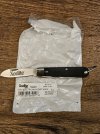majorpain1
Gold Member
- Joined
- Jan 9, 2019
- Messages
- 1,552
The BladeForums.com 2024 Traditional Knife is available! Price is $250 ea (shipped within CONUS).
Order here: https://www.bladeforums.com/help/2024-traditional/
A big shout going out to Dansf fanatic for enabling this latest a Camelbone Lamb Foot by Ashley Harrison at Wright Sheffield. This has another significance apart from being a fine individual knife, it was originally intended for our late Forumite and friend @cigarrodog whose death has deprived the Forum of a fine contributor and talented photographer. I responded to Dan and offered to buy the knife and the proceeds went to a charity for Dogs that Harvey liked, from a very sad event something good has happened. Renewed homage to the late Harvey & his family.
Very well finished, no gaps or issues but needs a decent flush out and sharpening, Camelbone is a favourite of mine.
Thanks again to Dan, Will.
View attachment 2267097I've been looking at one of these but have seen wide array of opinions from bad to really good.how are you liking it so far.robert

Could you elaborate a bit on Père David Stag? And its use by A. Wright. First time I've heard about it.Here is a smaller Pruner style Swayback that I bought about 3-4 years ago, it was claimed to be Père David Stag but I actually think it's Sambar as it's very deeply grooved both sides, I gave it a tea dye bath and it took very good colour.


Only six more?
I'll try. But I could be misguidedCould you elaborate a bit on Père David Stag? And its use by A. Wright. First time I've heard about it.
Thanks will,by chance do you have before and after of teabag dip.l actually like this one better then the camel bone.it is just finding a reputable source for canada.thanks again.

Thanks. Concerning availability of stag: I'm living half an hour from from Solingen. Knifemakers that do folders are Otter, Hartkopf, Klaas, Puma and Böker. Böker and Puma produce internationally, with a few or a very few knives being made in Solingen. The knifemakers in Albacete, Thiers and Maniago have kept bigger production volumes, different topic.I'll try. But I could be misguidedMost connoisseurs find Sambar deer to provide the best quality Stag for knife handles, combination of bark, texture or deep grooves plus it is consistent all the way through & solid. It is the type of Stag used on more costly knives or on vintage knives. The Sambar deer originates in India and over the years the Indian govt imposed bans on export of Sambar antler as numbers were diminishing. Some is over hunting (not waiting till the antlers are shed due to premium prices ) but much is destruction of habitat by human encroachment etc. So the supply became reduced. The alternatives are et al. European Red Deer, American Elk, Père David, Reindeer and other species but most of it is more porous or pithy than Sambar, less attractive generally, Sambar ages very impressively too.
However there are odd paradoxes here. Sambar Deer have been introduced into Australia & the US, possibly elsewhere and number have exploded (no Tigers there...Sambar being a great favourite of theirs...) and I understand they are shot for sport or even ruled as invasive, so why isn't this a source of Sambar Stag? Perhaps the quality is inferior due to genetics, terrain or just snobbery about 'real' Indian Sambar? Don't know but it's a valid question. Additionally, the Père David Deer (named after a Jesuit) became extinct in its native China sometime in the c20th. Some individuals were taken to European Zoos and the 9th Duke of Bedford established a colony and thriving Deer Park of them in England in the early c20th. His descendants sent numbers back to China to repopulate in the 1980s. Père David deer were also established in the US hence its use as an option for knife handles.
It seems that Père David Stag has been used in the US and England as a substitute for Sambar Stag as it is relatively plentiful, this might well be why Wright uses it due to its lower cost and ease of delivery? It presents as much less bark or featured than Sambar, but can be attractive as polished Stag. The example I showed is I believe, Sambar as it is very deeply grooved and might have been some older stock, but can't say for certain . It could be Père David, have not seen any so deeply grooved though. Other examples that I've seen shown on this Forum are usually rather smooth but not bad for it.
Much confusion surrounds 'Stag' some people are duped by words like Bonestag, or Stagbone- they're not antler but bone made to look like it- sometimes synthetics too. Then several deer ( cervidae) species are used for Stag handles,
Now somebody needs to show their newest Stag knife
CV or stainless? I’ve been meaning to pick up a yellow CV trapper for a while, I just never get around to it. It’s an iconic Case knife.Picked this up today, along with a matching sod buster jr that I gifted a friend. View attachment 2319522
